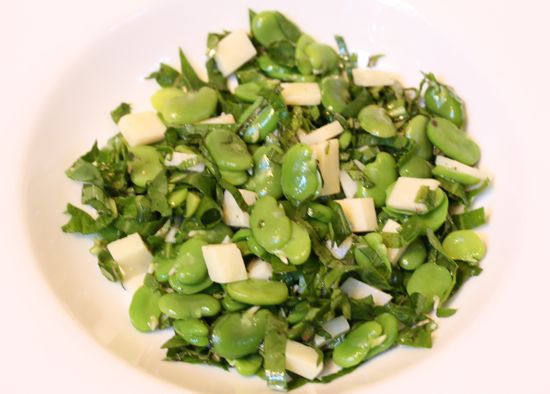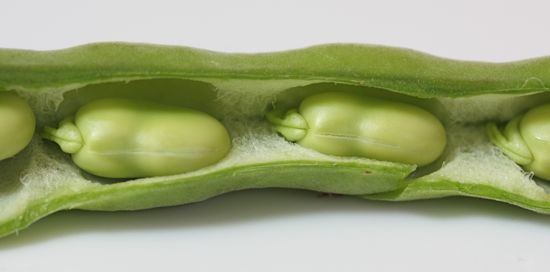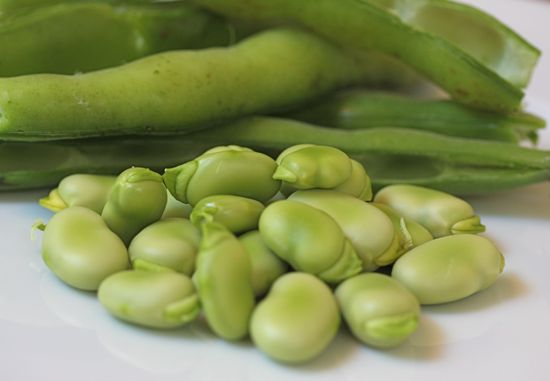
Sometimes there aren’t any shortcuts to good food. If you want the flavor of the real thing, you just have to put in the time and effort.
Fresh fava beans are a prime example. Each plump little bean must be liberated from its cozy cocoon within a sturdy pod before you can even think about peeling and cooking it.
Yet these beans are so wonderful that cooks around the world are happy to spend the time shucking and peeling them for everything from a simple antipasto to a spring stew with artichokes and new potatoes. The subtle flavor is one of the true delights of spring – fresh and sweet with buttery overtones and just a faintly bitter finish.
This year, I fell in love with a salad of tender spring favas and salty pecorino cheese tossed with fresh arugula, basil and mint that I found in Sara Jenkins’ Mediterranean cookbook “Olives and Oranges,” Houghton Mifflin, 2008. Simply dressed with olive oil and sea salt, it’s a feast of the season. Once you have shucked and peeled the favas, most of the work is done. If they’re really small and tender, you may not have to peel them at all.
 Jenkins suggests serving the beans raw if they’re very young and fresh. But I found only a tiny proportion of my beans were small enough for that, so I just snacked on the little ones while I prepared the larger beans for a quick blanch in boiling water before peeling. By the time I had worked my way through three pounds of beans, I’d found my rhythm.
Jenkins suggests serving the beans raw if they’re very young and fresh. But I found only a tiny proportion of my beans were small enough for that, so I just snacked on the little ones while I prepared the larger beans for a quick blanch in boiling water before peeling. By the time I had worked my way through three pounds of beans, I’d found my rhythm.
Think of it as a meditative experience, slowing time and focusing your mind. We all need a bit more of that in our lives.
Although the recipe calls for microgreens, it works nicely with a chiffonade of arugula and herbs. Just stack the leaves in bundles, roll into cylinders and slice crosswise into fine ribbons. I also added a shot of lemon juice and a little grated zest to perk up the flavors.
When choosing favas, look for pods that are smooth, glossy and pale green without wrinkles or blackening on their ends. Bulging, exceptionally thick pods are a sign of large beans, which are likely to be starchy and less flavorful. When you rip open the pods, the cottony white lining should be moist and the beans should be plump and fill out their skins.
To peel larger beans, pop them in boiling water for about a minute, then drop them into ice water to stop the cooking. Using a knife or your thumbnail, slit the peel at one end, then squeeze each bean between thumb and forefinger until the seed pops out.
You’ll need nearly a pound of whole pods per serving. Shucked and peeled, they’ll produce about 4 ounces of bright green beans.
Not everyone can eat favas, I’m sorry to say. A small number of people with an inherited enzyme deficiency known as favism suffer serious flu-like symptoms after eating them. Most are males with roots in Africa, the Mediterranean or Southeast Asia.
Luckily, I don’t have to worry about that. When the first shiny pods of young favas show up in the local markets, I go on a binge. The season doesn’t last long.

Serves 4
3 pounds young fava beans, removed from pods
6 ounces medium-aged pecorino cheese
1 cup loosely packed arugula
¾ cup loosely packed basil leaves
½ cup loosely packed fresh parsley
½ cup loosely packed fresh mint leaves
¼ cup extra-virgin olive oil
Juice of 1 small lemon, preferably Meyer
1 tablespoon grated lemon zest
½ teaspoon fleur de sel or other medium coarse sea salt
Coarsely ground black pepper to taste
If your favas are very small and tender, you may not have to peel them. If their peels are thick, tough and bitter, however, you’ll need to blanch and peel them. Drop them into a pot of boiling water a minute or so, drain and plunge into ice water to stop the cooking. Remove the peel by slitting one end with a small knife or thumbnail and pinching the bean until the seed pops out.
Cut cheese into ¼-inch cubes. Slice arugula, basil, parsley and mint crosswise into thin shreds. Toss greens with favas and cheese cubes in a large bowl. Drizzle with oil and toss again, adding a little more oil if necessary to lightly coat all the ingredients. Drizzle with lemon juice, sprinkle with zest, season with salt and pepper and toss. Serve immediately.
Adapted from “Olives and Oranges,” by Sara Jenkins and Mindy Fox.
